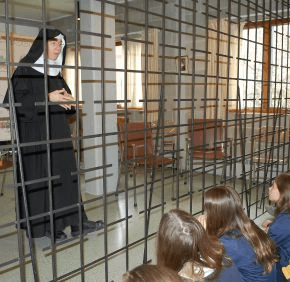By Cori Fugere Urban
Catholic News Service
WESTFIELD, Vt. – The joy of youth met the joy of consecrated religious life when sixth-graders from St. Francis Xavier School in Winooski visited the Benedictine nuns of the Monastery of the Immaculate Heart of Mary in Westfield.
On one side of the grille that separates the nuns from the outside world were the children in their blue and white school uniforms, with the nuns in their black and white habits on the other.
The students in Teresa Hawes’ sixth-grade homeroom visit the monastery each spring. This year they attended Mass, listened to a presentation about the nuns’ lives, presented a brief musical program and hand-delivered the proceeds they earned by making colorful rosaries out of nylon fishing cord.
Several years ago, Hawes showed one of the rosaries made at the monastery to her class, and students were enthusiastic about learning to make them. She returned to the monastery to learn how to tie the knots in such a way to make “beads” on the rosary, then taught her students.
As a service project, the students make the rosaries as well as one-decade strands and sell them at a school fair and at area parishes for $2.50 and $1, respectively. “People always give more,” said Hawes, who teaches French and religion at St. Francis Xavier School.
This year, thanks to the students’ efforts and individual generosity, the nuns gratefully received $550.
“The fact that they work on those rosaries … and give the proceeds to us makes us feel part of their work,” said Mother Laurence Couture, prioress.
Sixteen sisters were present for the presentation; 14 students traveled by school bus for the visit.
While there, Sister Benedict stood behind the grille to tell them about the life of the nuns and their focus on prayer and work. “That sums up the whole of our life,” she said.
“Ora et labora” is Latin for prayer and work.
She said prayer is the most important part of the nuns’ life, and they pray frequently during the day. The nuns consecrate their life to God and take vows of stability, poverty, chastity and obedience.
The latter, she surmised, is the most difficult to understand for individuals today who have been taught to assert their independence and “be their own person.”
She said for the nuns, obedience means listening to the voice of God as expressed by their superior, the Rule of St. Benedict and the community.
“Out of love, we submit ourselves … to imitate Christ.”
The nun explained that the grille is a symbol of their being separated exclusively for God’s service.
Their work entails the work of the mind – spiritual reading – and the work of their hands; their manual labor includes cooking, housekeeping, gardening and canning, hosting guests for quiet and reflection and making altar bread for use in churches throughout the United States and in Canada.
“We work pretty much in silence,” she said, “in order that we can keep united to God.”
The nuns enjoy one or two half-hours of recreation a day that includes talking, walking outside, playing games and even tobogganing in the winter.
“We do everything a family would because we are a family of sisters,” Sister Benedict said.
Jesse Gaudette, principal of St. Francis Xavier School, accompanied the students on their visit. “You can teach about vocations in the classroom or show (students) in real life,” he said. “They can read a book or we can tell them in the classroom (about monastic life) or we can take them here and they can see it, they can touch it, they can live it.”
Hawes said she is always amazed with the way the monastery touches the depths of the students’ beings. “They come back radiant. It’s about the life that is lived here that resonates in their baptismal grace, and it shines,” she told the Vermont Catholic, the magazine of the Burlington Diocese.
“They give their lives up for Jesus because He gave His life for them,” said Maelyn Sartwell, 11.
Urban is staff writer for Vermont Catholic magazine, official publication of the Diocese of Burlington.


